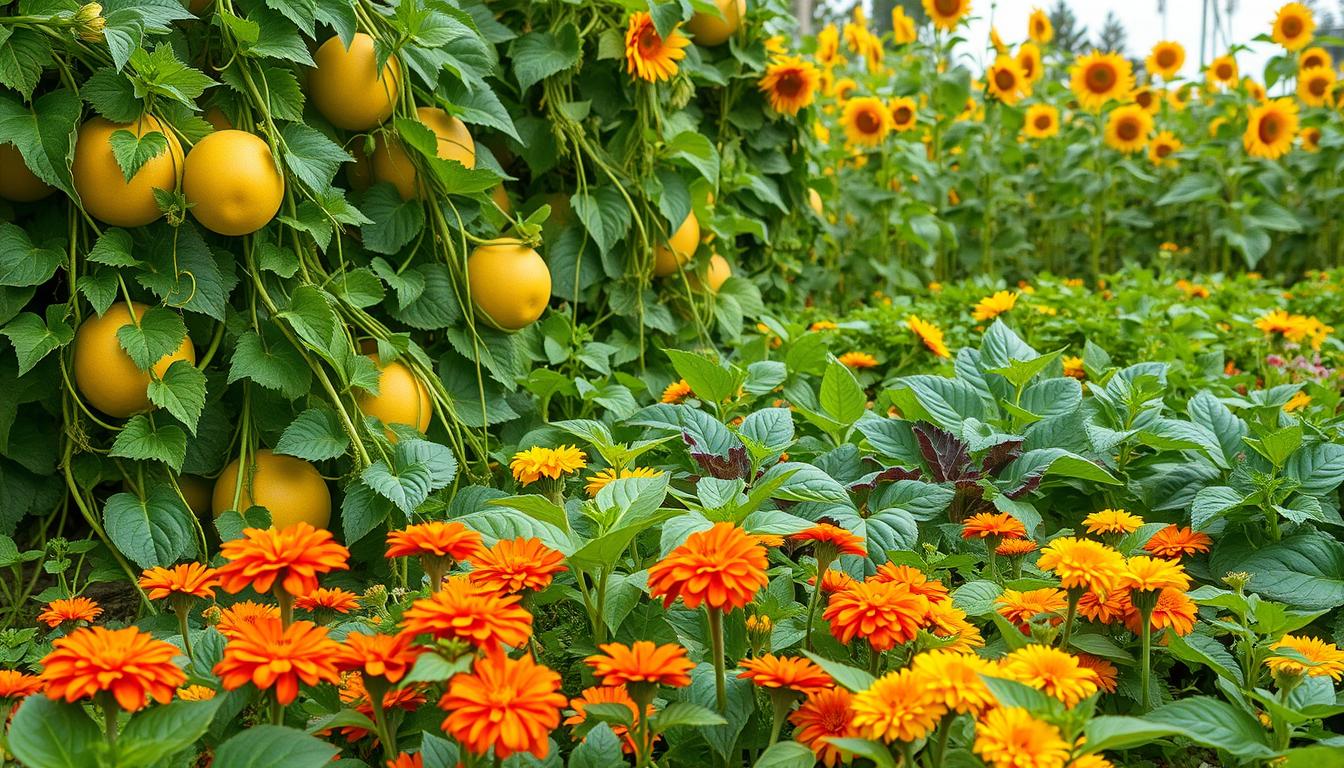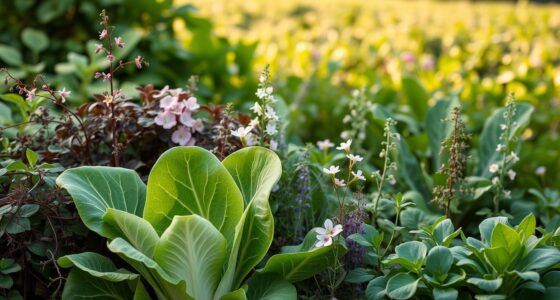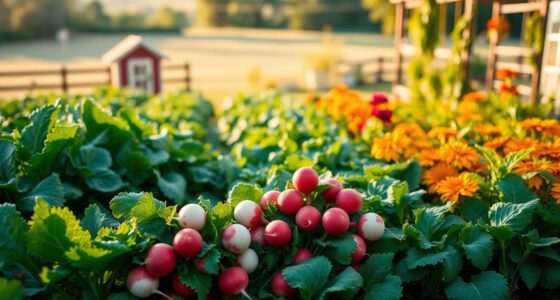Imagine the first warm day of summer, the sweet aroma of ripe cantaloupe wafting through your garden, evoking nostalgia and a sense of satisfaction. Perhaps you’ve already tasted the juicy fruit, harvested by your own hands, or you’re dreaming of frosty smoothies or refreshing summer salads. Cultivating cantaloupe isn’t just about planting a seed; it’s about creating a harmonious ecosystem where your fruits thrive. The choice of cantaloupe companion plants can significantly impact your garden’s yield, health, and resilience. Understanding the best companion plants for cantaloupe will enrich your gardening experience and elevate your harvest every season.
Key Takeaways
- Cantaloupe thrives when paired with the right companion plants.
- Companion planting enhances growth and pest resistance.
- Natural ecosystems flourish with well-chosen planting partners.
- Optimizing your garden layout can lead to bountiful harvests.
- Engaging with nature through gardening promotes mental well-being.
Why Companion Planting Matters for Cantaloupe
Understanding the reasons behind companion planting can significantly enhance your gardening experience, especially when growing cantaloupe. This method involves strategically placing different plants together to leverage their unique properties and promote a healthier garden ecosystem.
Benefits of Companion Planting
The benefits of companion planting are numerous. By incorporating companion plants alongside cantaloupe, you create a synergistic environment that encourages growth and vitality. Certain plants, like legumes, naturally enrich the soil with nitrogen, which is essential for nitrogen-hungry crops such as cantaloupe. As these plants thrive together, they support each other by improving resilience against various stressors.
Enhancing Growth Through Symbiosis
Companion planting facilitates a symbiotic relationship in the garden. By choosing plants that complement each other, you can enhance growth rates and yield. For example, planting flowers like marigolds can attract beneficial insects that help pollinate your cantaloupe and eliminate harmful pests. This holistic approach strengthens plant health and improves overall productivity.
Pest Control and Disease Prevention
Effective pest control with companion plants plays a crucial role in maintaining a thriving garden. Certain companion plants release natural compounds that repel pests, reducing the need for chemical pesticides. Furthermore, these plants can provide habitat for predatory insects that manage pest populations, promoting biodiversity within your garden. Consequently, this natural pest management results in healthier cantaloupe susceptible to fewer diseases.
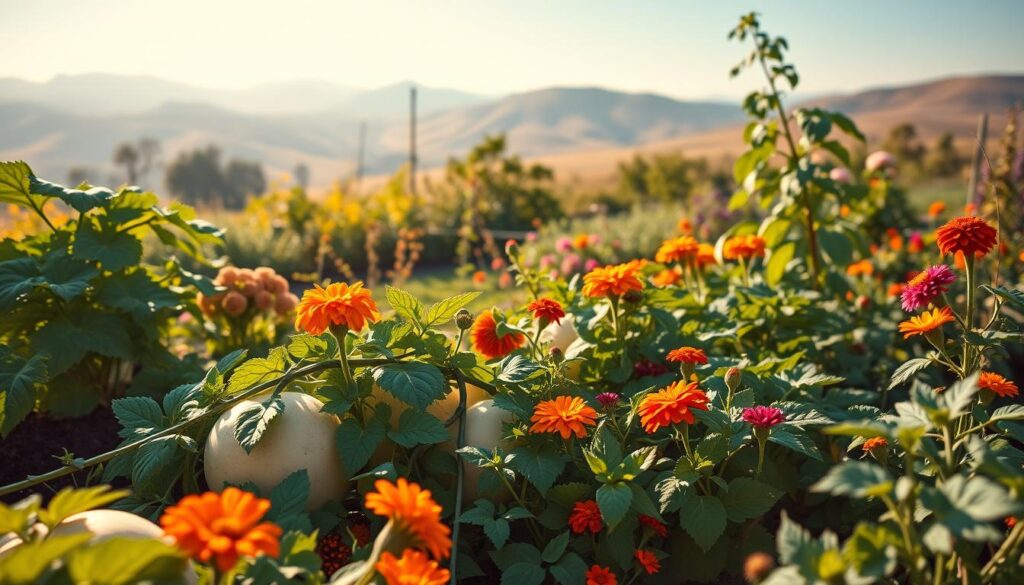
Ideal Cantaloupe Companion Plants
Choosing the best companion plants for cantaloupe can significantly enhance your garden experience. These pairings not only facilitate better growth but also help in creating a balanced ecosystem. Here are some ideal companions that elevate cantaloupe plant pairings.
Beans: The Nitrogen Fixers
Beans, especially bush varieties, play a crucial role in enriching the soil with nitrogen. This nutrient is essential for the vigorous growth of cantaloupe plants. By including beans in your garden, you will cultivate a thriving environment that supports luscious cantaloupe production.
Marigolds: Natural Pest Deterrents
Marigolds are another excellent choice among the best companion plants for cantaloupe. Their vibrant blooms not only brighten your garden but also act as natural pest deterrents, especially against nematodes and cucumber beetles. By planting marigolds, you can create a healthier habitat for your cantaloupe plants.
Nasturtiums: Attracting Beneficial Insects
Nasturtiums serve a dual purpose in the garden by attracting beneficial insects while also acting as trap crops. These vibrant flowers draw aphids away from your melons, effectively safeguarding them from pests. Their presence promotes an inviting atmosphere for hoverflies and other insects that contribute positively to your garden.

Herbs That Pair Well with Cantaloupe
Incorporating beneficial plants for cantaloupe into your garden can create a thriving ecosystem. Companion planting with herbs not only enhances the flavor of your cantaloupe but also offers protection against pests and promotes plant health. Here are a few herbs that work exceptionally well alongside cantaloupe.
Basil: Flavor Booster and Pest Repellent
Basil is well-known for its flavorful leaves that complement many dishes, but it also serves as a potent pest repellent. This herb can help keep pests like thrips at bay, allowing your cantaloupe to grow healthily. By planting basil nearby, you can enjoy both culinary benefits and increased protection for your garden.
Dill: Attracting Good Bugs
Dill is another herb that enhances your garden environment. It attracts ladybugs, which are natural predators of aphids, making them a valuable ally for your cantaloupe plants. By inviting these good bugs into your garden bed, you can reduce the risk of aphid infestations that may compromise your crop.
Oregano: Strengthening Plant Health
Oregano is not only a flavorful herb, it also has impressive pest-repelling qualities. This herb can also attract beneficial insects that support pest management in your garden. When planted alongside cantaloupe, oregano contributes to strengthening plant health, ensuring your garden flourishes.
| Herb | Benefits |
|---|---|
| Basil | Boosts flavor, repels thrips |
| Dill | Attracts ladybugs, controls aphids |
| Oregano | Repels pests, attracts beneficial insects |
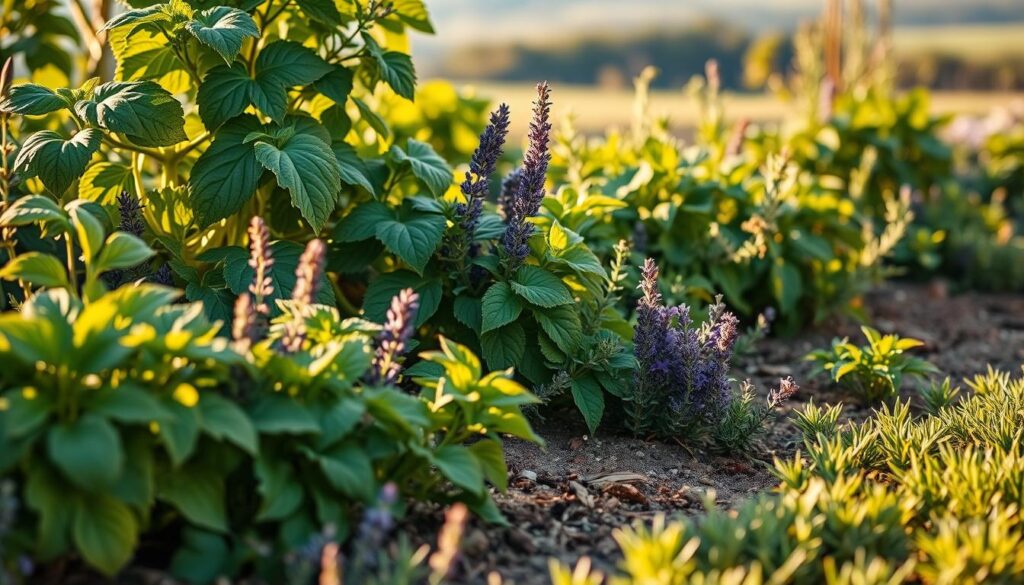
Vegetables to Pair with Cantaloupe
Integrating certain vegetables with cantaloupe can enhance your garden’s productivity and health. These combinations create the ideal environment for cantaloupe plants to thrive while utilizing space and resources efficiently. Let’s explore some of the best vegetables that serve as perfect companions for cantaloupe.
Corn: Providing Structure and Shade
Corn offers vertical growth that not only provides support to climbing plants but also delivers shade on hot days. This is beneficial for cantaloupe, which appreciates cooler soil temperatures. The cantaloupe garden companions formed between corn and cantaloupe create a harmonious ecosystem, enhancing overall garden productivity.
Radishes: Great for Soil Aeration
Radishes grow quickly and are fantastic for aerating the soil. Their roots break through compact soil, allowing essential nutrients and moisture to reach the cantaloupe roots more effectively. Including radishes in your garden alongside cantaloupe ensures that these vegetables flourish together, supporting healthy growth.
Onions: A Layer of Defense
Onions work as natural pest deterrents due to their strong scent, which repels many common garden pests. Additionally, they have minimal competition for nutrients and space when paired with cantaloupe. Including onions in your planting can create a balanced environment that helps your cantaloupe thrive.
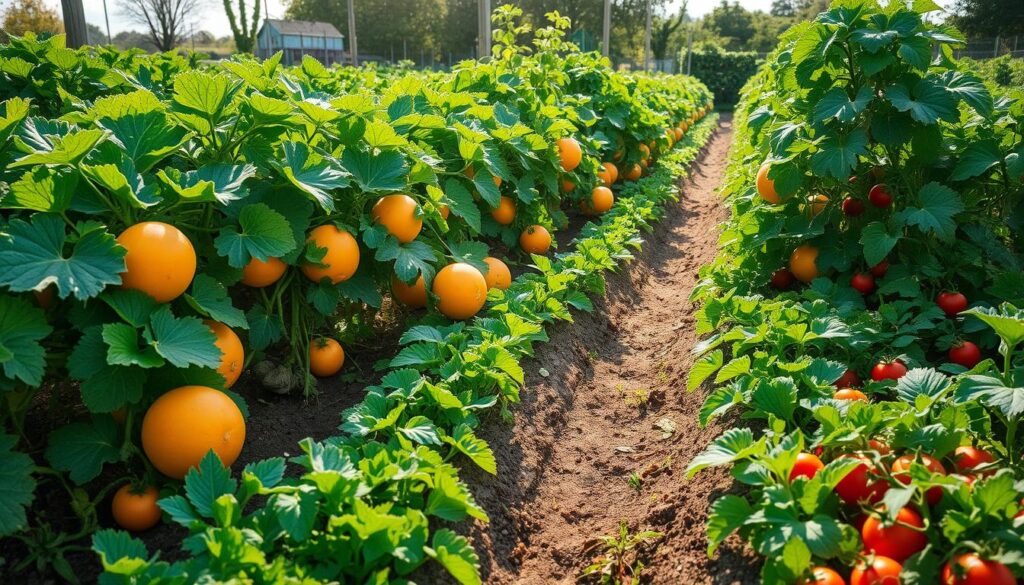
Flowers That Benefit Cantaloupe Growth
Incorporating flowers with cantaloupe not only enhances the visual appeal of your garden but also contributes significantly to the health and productivity of your plants. Companion flowers help create a balanced ecosystem, attracting pollinators and beneficial insects, while offering other advantages like pest control and soil enhancement.
Sunflowers: Pest Control Allies
Sunflowers stand tall and proud, providing an attractive focal point in your garden. These companion flowers serve as natural pest control allies, attracting pollinators such as bees. Their deep roots can also improve soil structure, benefiting the cantaloupe plants nearby by ensuring they have access to essential nutrients.
Zinnias: Attracting Pollinators
Zinnias are vibrant and cheerful, effectively attracting a variety of beneficial insects. Their strong appeal to pollinators supports the flowering process of your cantaloupe. Healthy fruit development relies heavily on the activity of bees and other pollinators, making zinnias a fantastic addition to your growing space.
Borage: Soil Enhancer with Medicinal Qualities
Borage is not just another flower; it is a powerhouse for soil health. Rich in potassium and calcium, borage enhances soil quality, creating a nourishing environment for cantaloupe growth. Furthermore, it attracts pollinators, helping ensure that your cantaloupe yield is plentiful and robust.
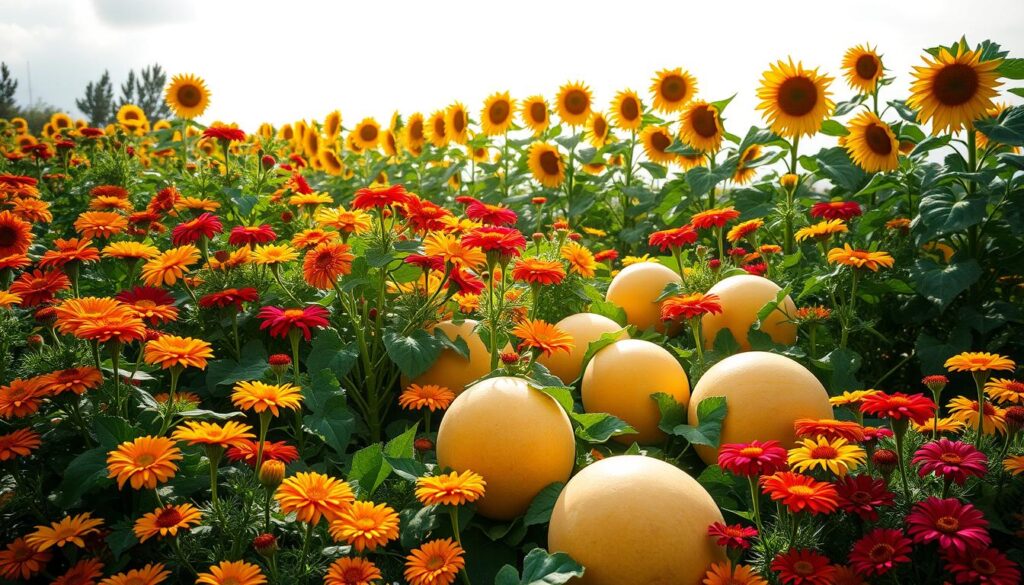
Companions to Avoid for Cantaloupe
When planning your garden, knowing what not to plant with cantaloupe is crucial for promoting healthy growth. Certain plants can negatively impact cantaloupe by introducing diseases or competing for essential resources. By understanding these relationships, you can enhance the overall health of your garden.
Nightshades: Potential Diseases
Plants from the nightshade family, such as tomatoes and peppers, can share diseases with cantaloupe. These plants may introduce pathogens that can compromise the health of your cantaloupe plant neighbors, leading to diminished yields and increased vulnerability to pests. Keeping nightshades at a safe distance is advisable to maintain a healthy garden environment.
Cucumbers: Competition for Resources
Cucumbers are another plant to avoid. Both cucumbers and cantaloupe require similar resources, including water and nutrients. Planting them too close can lead to competition, potentially stunting the growth of both crops. To ensure that your cantaloupe plants thrive, it is wise to plant cucumbers elsewhere in your garden.
Potatoes: Nutrient Conflicts
The presence of potatoes in your garden can create nutrient conflicts. Potatoes are heavy feeders, consuming large amounts of soil nutrients that your cantaloupe requires. This competition may result in weaker cantaloupe plants. Choose companions that complement your cantaloupe rather than ones that strip the soil of vital elements.

Planting Techniques for Cantaloupe Companions
Utilizing effective gardening techniques helps create a thriving environment for your cantaloupe and its companions. Each method contributes to maximizing space, ensuring productivity, and enhancing the growth of your plants. Explore these practical planting techniques for successful garden synergy.
Intercropping: Maximizing Space
Intercropping involves growing compatible plants together in the same space. This technique allows you to make the most of your garden area. By choosing suitable planting partners for cantaloupe, such as beans or marigolds, you enable plants to share resources, improving nutrient availability and optimizing light exposure.
Succession Planting: Continuous Harvest
Succession planting keeps your garden productive throughout the growing season. By staggering your planting times, you can enjoy a continuous harvest of cantaloupe and its companions. This technique ensures you have fresh produce available while reducing the risk of overplanting and subsequent waste.
Companion Plant Grouping: Effectiveness
Grouping companion plants together provides them with mutual benefits. For example, planting herbs such as basil near cantaloupe can enhance flavors while deterring pests. This grouping approach is an effective gardening technique that fosters a robust ecosystem, encouraging healthier growth and reducing the need for chemical pest control.
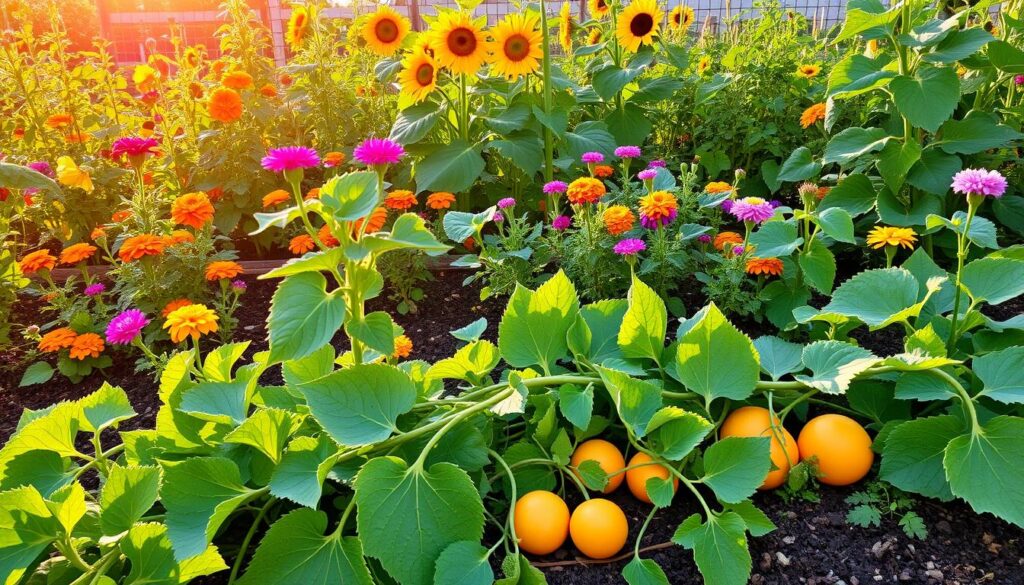
| Technique | Description | Benefits |
|---|---|---|
| Intercropping | Growing compatible plants together | Maximizes space, shares resources |
| Succession Planting | Staggering planting times | Ensures continuous harvest, reduces waste |
| Companion Plant Grouping | Grouping mutually beneficial plants | Enhances growth, deters pests |
Best Soil Conditions for Cantaloupe and Their Companions
Cantaloupes flourish when supported by optimal soil conditions. Understanding the specific needs of cantaloupe plants ensures a fruitful harvest and a healthy garden. A focus on soil pH levels, drainage, and nutrient-rich soil will significantly enhance plant growth.
Soil pH Levels: Finding the Sweet Spot
The ideal soil pH for cantaloupe falls between 6.0 and 6.8. This range promotes the most effective nutrient uptake. Testing your soil regularly can help you maintain these levels, ensuring that your cantaloupe and companion plants receive the best possible conditions for growth.
Importance of Drainage and Moisture
Proper drainage is crucial for preventing root rot, a common problem in overly saturated soil. Cantaloupes require consistent moisture, particularly during their critical growing stages. Implementing methods such as raised beds and organic matter can enhance water retention while maintaining good drainage.
Nutrient-Rich Soil: Feeding Your Plants
Nutrient-rich soil is vital for healthy cantaloupe growth. Enriching your garden with organic compost and well-rotted manure can boost soil fertility. This nourishment supports not only your cantaloupe but also its companion plants, creating a robust garden ecosystem.
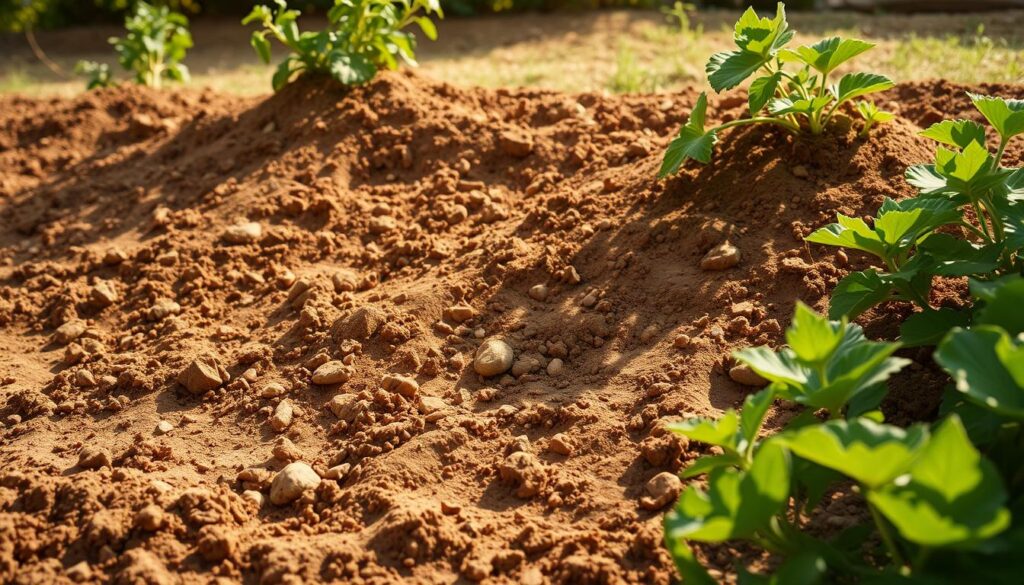
Watering Practices for Cantaloupe Companions
Effective watering practices ensure your cantaloupes and their companion plants thrive throughout the growing season. Consistency and proper timing play significant roles in maintaining healthy plants. You will achieve more robust growth by preventing stress through adequate hydration.
Consistency: Keeping Roots Hydrated
Regularly watering cantaloupe is essential, particularly during dry periods. Deep watering encourages roots to grow strong and reach for moisture, making them more resilient. Consider using a drip irrigation system for companion plants, as it provides targeted moisture while minimizing waste.
Timing: Best Times to Water
The optimal time for watering is in the early morning. This practice reduces evaporation and allows plants to absorb moisture effectively. Watering your plants at the right time can significantly impact their overall health and productivity.
Mulching: Retaining Moisture
Applying mulch around your cantaloupe and companion plants can effectively retain soil moisture. Mulch also helps to suppress weed growth and maintain a more stable soil temperature. Organic mulches, such as straw or wood chips, can enhance soil quality as they decompose over time.
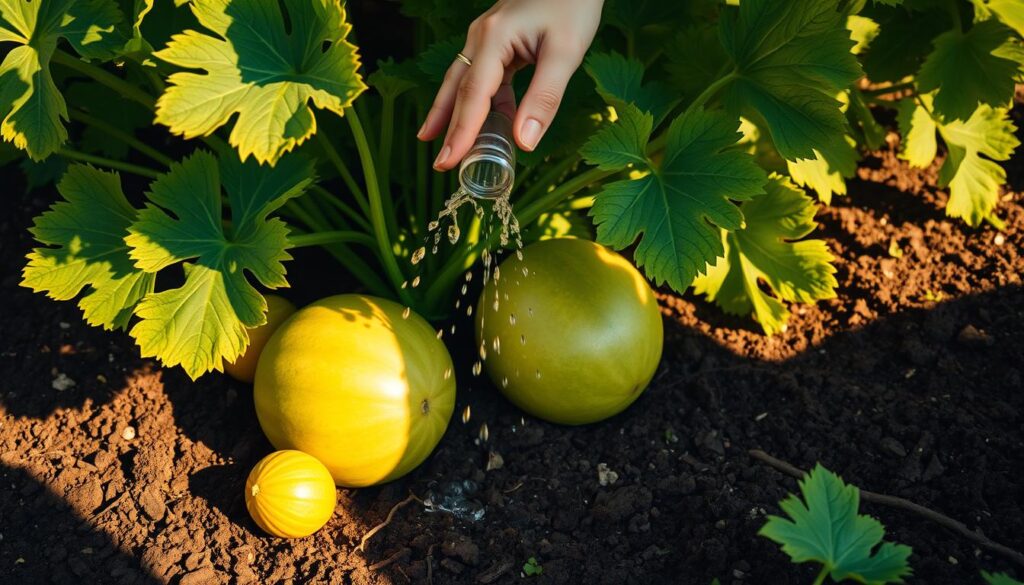
Sun Requirements for Cantaloupe and Companions
Cantaloupes flourish in sunny environments, making them highly dependent on proper light conditions. Understanding the sun requirements for companion plants is vital for ensuring your garden supports healthy growth without overshadowing the melons.
Full Sun: Ideal Conditions for Growth
Your cantaloupe plants thrive on sunlight for cantaloupe, needing at least 6 to 8 hours of direct sunlight each day. This exposure promotes photosynthesis, which is essential for lush growth and fruit development. Planting in an area that maximizes sun exposure will yield sweet and juicy melons.
Companion Shade Needs: Balancing Light
While cantaloupes bask in the sun, some companion plants may have different light requirements. Certain herbs and flowers might prefer partial shade. Consequently, effective garden planning ensures that taller plants or those with larger foliage do not obstruct sunlight from reaching your cantaloupe. Consider grouping companion plants based on their sun requirements to create a harmonious and productive garden layout.

| Plant Type | Sunlight Requirement | Companion Compatibility |
|---|---|---|
| Cantaloupe | Full Sun (6-8 hours) | High Compatibility |
| Basil | Full Sun (6-8 hours) | High Compatibility |
| Dill | Full Sun (6-8 hours) | Moderate Compatibility |
| Marigolds | Full Sun (6 hours) | High Compatibility |
| Tall Sunflowers | Full Sun (6-8 hours) | Moderate Compatibility |
| Nasturtiums | Partial Shade to Full Sun | Moderate Compatibility |
When to Plant Cantaloupe and Its Companions
Knowing the right timing for planting cantaloupe and its companions is essential for a fruitful garden. You should aim to plant after the last frost date in your area to ensure optimal conditions for growth. This understanding greatly affects your planting dates for cantaloupe and can significantly enhance your overall harvest potential.
Understanding Frost Dates
Frost dates vary depending on your geographical location. Research your local climate to determine the last frost date in spring. This information is crucial for planning. Planting around this date helps prevent damage caused by unexpected cold snaps.
Timing for Optimal Growth
The best time to plant companion plants is usually coinciding with cantaloupe planting. This approach creates a harmonious ecosystem that benefits all plants involved. When you time your planting correctly, you cultivate healthier plants, leading to greater yields and a thriving garden.
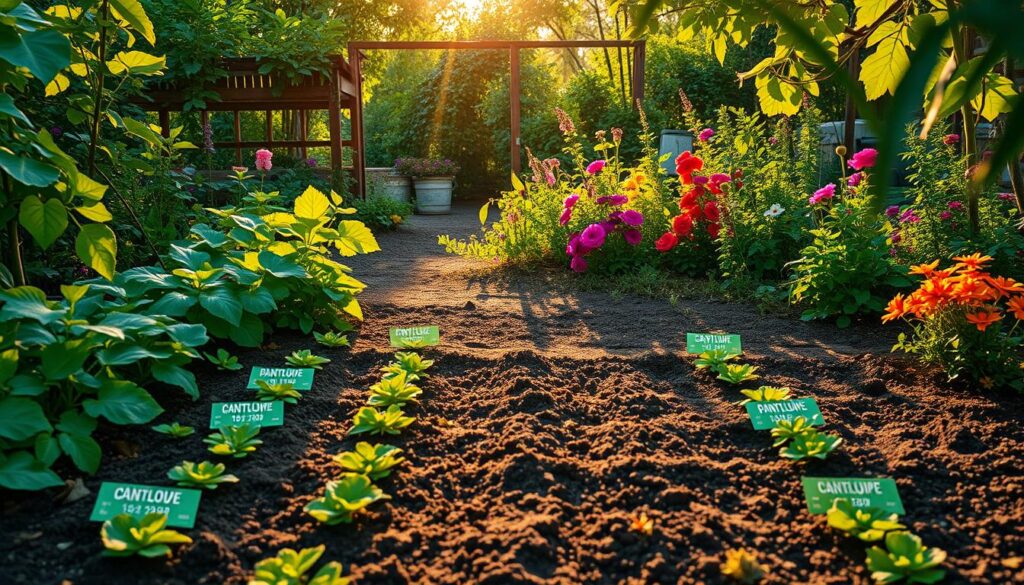
Cantaloupe Pest Management with Companion Plants
Managing pests in your cantaloupe garden is crucial for ensuring healthy growth and abundant harvests. Pests like aphids and cucumber beetles can pose a significant threat to your crops, leading to reduced yields. By integrating companion plants into your gardening strategy, you can enhance your pest management for cantaloupe and enjoy a thriving garden through controlling pests naturally.
Recognizing Common Pests
Identifying the typical pests that target cantaloupe is the first step in effective management. Key pests to watch for include:
- Aphids: Small insects that can quickly overpopulate and sap plant vitality.
- Cucumber beetles: These pests can harm young plants and transmit diseases.
- Spider mites: Tiny pests that can create webbing and cause leaf discoloration.
Being vigilant about pest presence allows you to take action before infestations escalate.
Role of Companion Plants in Pest Control
Utilizing companion plants is an effective strategy for pest management. Marigolds, for example, can attract beneficial insects that prey on harmful pests. Nasturtiums are known to repel aphids, providing an additional layer of protection for your cantaloupe. This symbiotic relationship among plants fosters a balanced ecosystem in your garden, further aiding in controlling pests naturally.
| Companion Plant | Pest Control Benefit |
|---|---|
| Marigold | Attracts ladybugs and lacewings, natural predators of aphids |
| Nasturtium | Repels aphids and attracts predatory insects |
| Basil | Natural repellent for flies and mosquitoes |

Incorporating these companion plants not only enhances the health of your cantaloupe crops but also enriches your garden’s biodiversity overall. With thoughtful planning and an understanding of the pest dynamics, achieving successful pest management for cantaloupe becomes an attainable goal.
Harvesting Your Cantaloupe and Companion Plants
Understanding the right time for harvesting cantaloupe is crucial for enjoying its sweet flavor. The aroma emitted from a ripe cantaloupe, combined with a slight give at the stem end, signals that the fruit is ready to be picked. Knowing when to pick companion plants harmonizes with this timing, ensuring that everything in your garden maximizes its potential without overshadowing one another.
Recognizing Ripeness for Cantaloupe
To determine if your cantaloupe is ripe, there are a few key indicators to observe:
- The external skin should change to a golden or yellow hue.
- A fruity aroma becomes noticeable, especially near the stem.
- A gentle pressure against the stem side should result in a slight indent.
By watching for these signs, you can ensure that your harvesting cantaloupe is at its peak flavor and sweetness.
Timing for Companion Harvests
For a fruitful gardening experience, synchronize your harvest times. Here are some tips:
- Plan to harvest companion plants either just before or after you pick your cantaloupe.
- Avoid picking companion plants too late, as they may steal nutrients and light from your cantaloupe.
- Monitor the growth rate of companion plants to find the right moment for harvest.
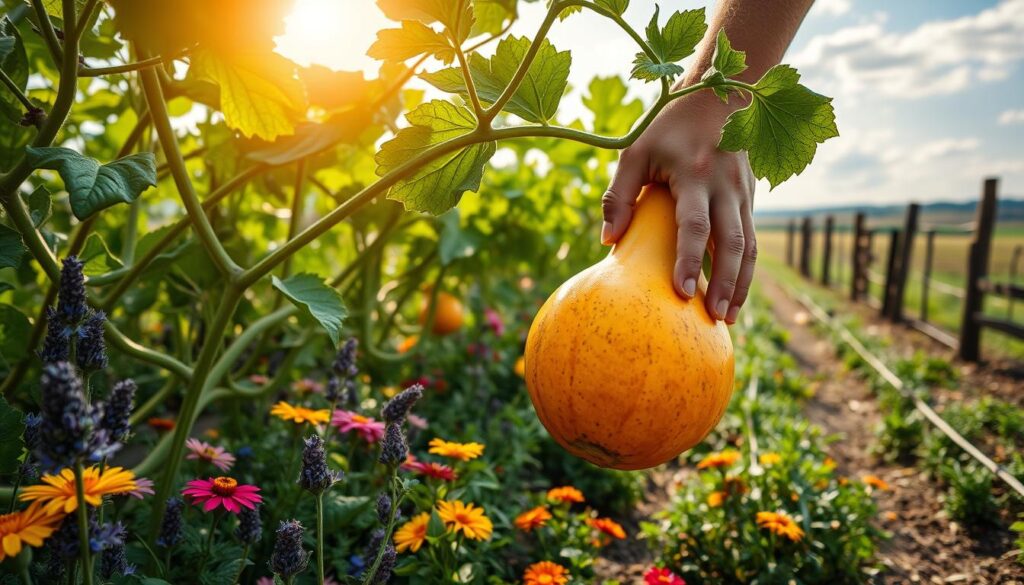
Long-Term Benefits of Companion Planting
Embracing companion planting brings numerous long-term advantages to your garden. By nurturing a diverse ecosystem, you cultivate an environment that thrives through collaboration among various plant species. This approach contributes significantly to enhancing garden biodiversity, creating a habitat that benefits both plants and wildlife.
Improving Soil Health
Companion planting enhances soil health by improving nutrient levels and promoting microbial activity. When specific plants are paired together, they can exchange nutrients and provide vital contributions to the soil structure. This organic method ensures that your cantaloupe plants receive the required nourishment while fostering a balanced ecosystem.
Sustaining Local Ecosystems
Utilizing companion planting strategies aids in sustaining local ecosystems. By attracting beneficial insects and pollinators, your garden becomes a refuge for various species. This ecological harmony enhances overall productivity, leading to healthier plants and a more vibrant garden atmosphere.
Enhancing Biodiversity in Gardens
Utilizing the benefits of companion planting leads to a rich tapestry of flora within your garden. Each plant plays a unique role, contributing to the resilience and adaptability of this green space. Promoting enhancing garden biodiversity not only benefits the plants but creates a holistic environment that encourages wildlife, ultimately enriching your gardening experience.
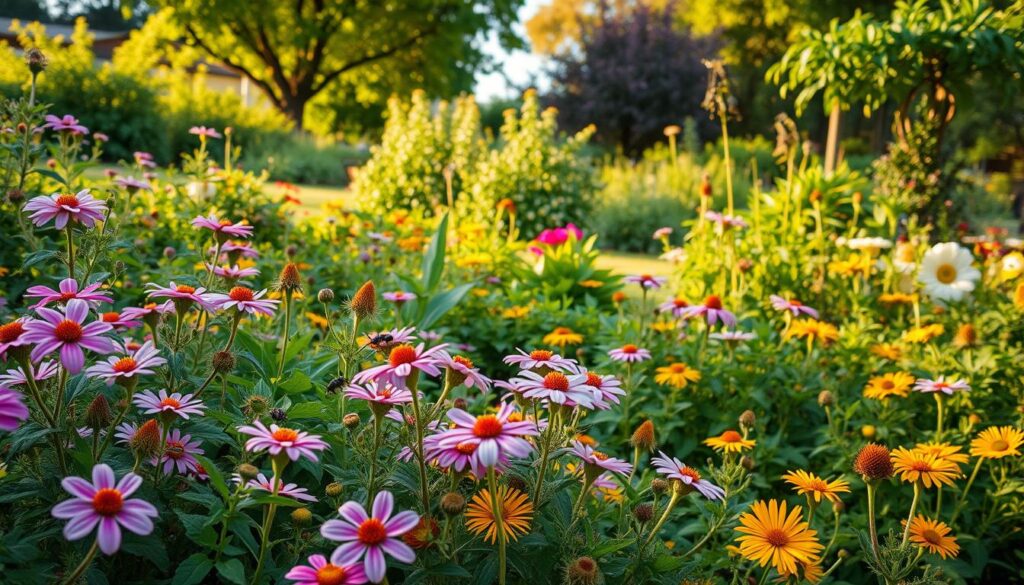
Final Tips for a Successful Cantaloupe Garden
Creating a flourishing cantaloupe garden involves more than just planting seeds and waiting. Regularly monitoring the growth of your cantaloupe and their companion plants is crucial. Check for signs of stress or poor health, and be prepared to make adjustments, whether that involves changing watering routines or addressing pest issues. These tips for cantaloupe gardening ensure that your plants remain productive and healthy throughout the growing season.
Engaging with your local gardening community can greatly enhance your gardening experience. Share your harvest with neighbors or fellow gardeners, as this not only fosters relationships but also creates a sense of support. Participating in community gardening events is a fantastic way to learn from others and exchange tips, which can improve your gardening skills.
Continuous learning is essential to becoming a better gardener. Explore new techniques, try different planting strategies, and stay updated on the latest developments in gardening. By expanding your knowledge, you will refine your methods for growing cantaloupe and their companions, leading to a more fruitful and enjoyable gardening journey.
